3.0 RESULTS
Table 1 provides the statistical summary of the location and cause for each ERNS report. Results are summarized for each year and for the entire period from 1987-96. Data for each location was also categorized by cause and by spilled substance. Results of this data analysis are summarized for each location and for all locations. This data summary is shown in Table 2.
3.1 DATA TRENDS
The frequency of ERNS reports is approximately 96 per year. The most spills reported in a year is 149 in 1992, and the lowest is 44, reported in 1996. Exhibit 3 summarizes the frequency of spills from 1987 to 1996.
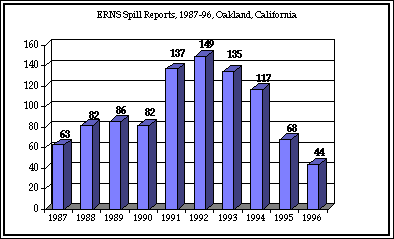 |
| EXHIBIT 3 - Spills Reported to ERNS |
Approximately two events per year result in an injury requiring a hospital visit. The most injury-related incidents occurred during 1992 when a total of five spills injured 24 people. No injury-related spills were reported to ERNS during either 1987 or 1995.
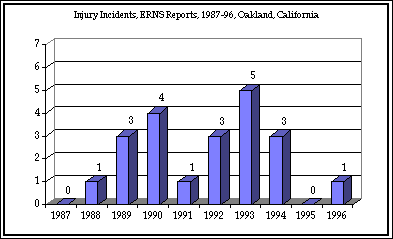 |
| Exhibit 4 - Spills Involving Injuries |
The most people injured during a single year was 36 in 1994. In one of three 1994 ERNS incidents, 33 individuals were sent to the hospital for decontamination after a firearm was discharged into an electrical transformer causing it to explode and spray transformer oil.
No spill incidents reportedly resulted in death. However, one ERNS incident did involve the removal of poisons from the scene of a suspected suicide.
3.2 SUBSTANCES SPILLED
The substances involved in ERNS were placed into nine separate categories as shown in Exhibit 5. The most common spilled substance was petroleum products accounting for 391 of the total 963 reports. The remaining categories included chemical (231), unknown (154), waste (67), paint (50), gas (42), asbestos (17), sewage (7), and radioactive material (4).
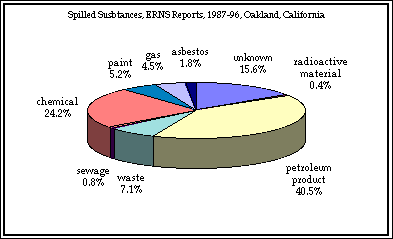 |
| EXHIBIT 5 - Spilled Substances Reported to ERNS |
Details on the substances categorized as chemicals, gas, radioactive and asbestos is provided in Exhibit 6.
The most common substance spilled is transformer and PCB oils comprising 21 of the 233 chemical spill events. Nine of the 21 incidents involving PCBs and transformer oil were reported due to a unique event, the 1991 Oakland Hills fire. However, even discounting the ERNS spill reports resulting from the Oakland Hills fire, transformer and PCB oil remains the most common spilled chemical substance (12 incidents). This result is consistent with an EPA review of their ARIP database (Accidental Release Prevention Requirements: Risk Management [Federal Register: March 13, 1995]) which indicated a large number of accidental releases from the electric utility industry. Although there were a high number of releases reported by electric utilities, the EPA noted that only about 2 percent of the industry accounted for the reported releases.
Asbestos was reported as a spilled substance in 17 incidents. Drug lab wastes also accounted for a relatively large number of ERNS reports (11 incidents). These incidents were generally a result of illegal dumping.
Chemicals used by the plating industry such as acids and cyanide combined, accounted for over 30 of the total chemical incidents (13%). The ERNS records for one facility, Francis Plating, show a history of releases due to violations of pollution prevention laws that culminated in a fire which caused evacuations of several hundred people. In 1993 alone, another plating facility, Jerry's Plating, had three ERNS incidents (illegal dumping, using hazardous materials for cleaning a floor, and an employee falling into a tank of acid).
A relatively large number of incidents (9) involved chemicals used to make polyurethane foam (toluene 2,4,-diisocyanate, diphenyl methane diisocyanate).
The 43 incidents involving gases included liquefied petroleum gas (14 incidents), ammonia (11 incidents), and chlorine (6 incidents). Both ammonia and chlorine are acutely toxic gases.
Though it is the least common of the spilled substances, radioactive material is a concern. The most serious incident, described in Exhibit 1, involved a leaking container of radioactive material. Two incidents involve the theft of radioactive material and the third involves the illegal dumping of a cylinder commonly used by hospitals to hold radioactive materials.
3.3 LOCATION
As shown in Exhibit 7, approximately 2.3 percent of the ERNS reports did not have an adequate site address to assign a location. A larger number of spills were reported in the water (121 of 963 or 12.6%). The remaining 820 spills were divided between the NICHE Project West Oakland Pilot Program area (475/820 or 58%), the remainder of Oakland (270/820 or 33%) and the highways (75/820 or 9%). The NICHE West Oakland Pilot area includes the residential/industrial area west of Telegraph Avenue as well as the Oakland Army Base, Naval Supply Center, Port of Oakland, and Union Pacific Railyard.
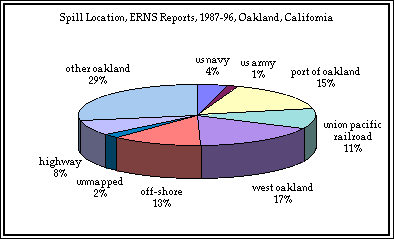 |
| EXHIBIT 7 - Spill Locations |
Within the West Oakland Pilot Program area 35 percent of the spills occurred in the mixed industrial/residential land use area, 31 percent of the spills were reported on Port of Oakland property, and 22 percent in Union Pacific Railroad property. The remainder was reported by the US Navy and US Army (11 percent combined).
3.4 CAUSE
As shown in Exhibit 8 the most common cause of an ERNS report is illegal dumping which accounts for about one in four reports. Illegal dumping is the number one cause of ERNS reports in West Oakland and the remainder of Oakland.
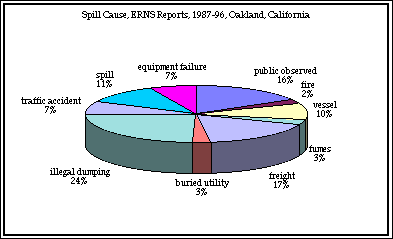 |
| EXHIBIT 8 - Spill Causes |
Freight accounted for 17 percent of the total accidents and was responsible for the majority of the spills at the Union Pacific Railyard, was the number two cause of spills at the Port of Oakland and on the Highway system and third most common cause of spills in West Oakland.
Public Observation also accounted for approximately 17 percent of the total ERNS reports. Public observations of off-shore oil sheens at Lake Merritt, the Oakland Estuary, Port of Oakland, and Naval Supply center accounted for 86% of the spills reported to ERNS by the public.
Spills caused by human error out pace spills caused by equipment failure by a ratio of three-to-two. Together these two causes account for 17.5 percent of the ERNS reports. Hazardous material regulations (spill prevention, risk management) are primarily designed to prevent these incidents involving human error and equipment failure. The NICHE Project analysis indicates that these two causes account for only one in six hazardous material incidents.
Marine Vessels (9 percent of the total) caused more spills than truck and rail traffic accidents combined (7.5 percent). Marine vessel accidents were the number one cause of ERNS reports at the Port of Oakland, Naval Supply Center and Oakland Army Base. Traffic accidents were the number one cause of an ERNS report on the Highway system and number two cause at the Union Pacific Railyard.
Fires, fumes, and buried utilities each account for 2 to 3 percent of the reported ERNS incidents.
4.0 DATA SOURCES
4.1 RTK Network
RTK NET was started in 1989 in support of the Emergency Planning and Community Right to Know Act (EPCRA), which mandated public access to the Toxic Release Inventory. It is operated by two nonprofit organizations--OMB Watch and The Unison Institute--and funded by various government agencies and foundations.
RTK NET was established in order to empower citizen involvement in community and government decision-making. RTK NET provides access to government databases and lets you search them for free. RTK NET has many databases on the environment. You can access RTK NET via the web (http://www.rtk.net), bbs, or telnet. RTK NET can be reached at:
Right-to-Know Network
1742 Connecticut Avenue, NW
Washington, DC 20009
Phone: 202/234-8494
Fax: 202/234-8584
Email:webmaster@rtk.net
4.2 ERNS Database
The ERNS is a nationwide, centralized database supported by EPA, the US Coast Guard (USCG) and the Department of Transportation (DOT) and maintained by the Transportation Systems Center (TSC). This information-sharing network documents every release notification received by the National Response Center, EPA Headquarters and Regional offices and the USCG.
ERNS is a documenting system not a tracking system. Only the initial notification of the release is documented, not the actions performed on the site. ERNS contains information on every reported release (including release of non-hazardous substances and releases below reporting quantity levels), not only those that result in removal actions. ERNS also provides assistance to regional enforcement personnel in supporting day-to-day response operations and enforcing release reporting requirements.
Exhibit 9 provides a diagrammatic representation of the ERNS Release notification process. Responsible parties, private citizens, or State or local officials may report a release to the NRC. The NRC documents the notification and relays the data to the appropriate On-Scene Coordinator (OSC) for a response determination. In the event that EPA or USCG is the first to be notified, the notified agency will document the release incident data
and relay the information to the appropriate OSC for response determination. When an EPA Region is the notified agency, the release data must be transferred within two weeks of receipt to the RCS for input into the NRC database.
To ensure the efficient functioning of ERNS, EPA regions and USCG field offices are responsible for:
- Taking calls from parties or NRC reporting oil spills or chemical releases
- Documenting the notification using a standard data collection form
- Making response determination
- Making follow-up calls to gather additional information
- Inputting all information into the system
- Relaying the release notification report within two weeks to the TSC
- Coordinating with States to facilitate their reporting into ERNS
EPA headquarters, in conjunction with USCG and DOT, are responsible for providing overall direction and guidance on the development and operation of ERNS. ERNS has been fully operational since October 1987.
The ERNS data is maintained by the US EPA. Further information on the database can be obtained from:
Office of Emergency and Remedial Response
Mail Code 5202G
401 M Street, S.W.
Washington, DC 20460
(202) 260-2342
erns.info@epamail.epa.gov
http://www.epa.gov/ERNS/docs/erns_doc.html
4.3 ERNS DATA LIMITATIONS
The EPA warns to be aware of the following factors which can affect the quality of ERNS data:
- Completeness and accuracy: ERNS primarily contains initial accounts of releases, made during or immediately after an incident, when exact details are often unknown. These data are usually not updated unless an EPA Region is involved in the response action.
- Multiple notifications: Because the data are gathered from many sources, multiple notifications of some releases may exist. These may or may not be exact duplicates. Large releases, in particular, are prone to multiple notifications.
- Multiple sources: ERNS contains data from multiple sources (i.e., the NRC, the EPA Regions, and the USCG). Each agency has a slightly different mission and distinct data gathering requirements.
- Data updates: This database is updated regularly. Therefore, downloaded data may be changed by future updates.
- Data entry errors: Data in ERNS are generally reported over the telephone. Data inconsistencies should be investigated to ensure that they are not the result of data entry mistakes.
- Data structure changes: System upgrades, which include field additions and other database structure changes, have been made to improve data quality. However, structure changes that occur after a report is received, may make the report appear incomplete. Care must be taken when working with data that span several years.
- Unique events: Infrequent, unusual releases may affect statistical results. A release notification that grossly affects overall results should be examined further.
The EPA states that ERNS data are best used for:
Statistical analyses of large data sets: The effects of data inconsistency are diminished within large data sets because individual records are less likely to skew results.
Retrieving information about a specific release notification: Data inconsistencies are irrelevant when analyzing individual reports.
The EPA states that the following uses of ERNS Data be avoided:
Statistical analyses of small data sets, such as notifications from a single township over a short time span. Compared with the effects on a large data set, an incorrect record has more weight in a small data set and may skew the results.
The sole source of information about a release. All information in ERNS should be checked against as many other sources as possible.
4.4 DISCUSSION OF DATA QUALITY
Data limitations were recognized during this statistical study. Data qualification resulted in the removal of 113 mostly duplicate data records greatly reducing the limitations of the qualified data set.
Data entry errors are believed to exist within the data set due to inconsistent data fields (i.e. asbestos spill described as 500 to 1000 gallons per hour). Due to the large volume of data that was analyzed it is likely that the effect of data entry errors would be minimized.
The only unique event that appeared to impact data results of this analysis was the Oakland Hills fire in 1991. This single event was responsible for 40 percent of the releases caused by fire and for 43 percent of the releases of transformer oil/PCBs (43%).




